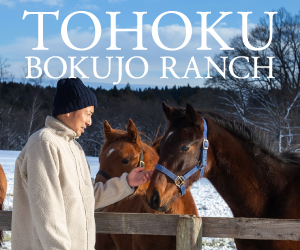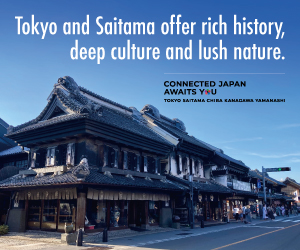TOKYO, CHUGOKU & SHIKOKU TRAVEL
Tokyo dazzles, hums, fascinates, educates and provides serene escapes into nature sanctuaries and havens that preserve Japan’s centuries-old traditions. Whatever one desires, it can be found in this singular metropolis that is so unlike any other in the world. But for all it has to offer, Tokyo isn’t all of Japan. To understand the soul of the country, one must know its capital but then venture beyond to where mountains lift up ancient temples, remote islands hide wonderful secrets and the sea creates landscapes of magic.
Thanks to its system of bullet trains and regional airports, all of Japan is open to travelers willing to step outside the well-known and familiar and head westward toward places like Yamaguchi or Shimane, or across the Seto Inland Sea to Ehime, Kochi and other prefectures on Shikoku, the smallest of the country’s four main islands. This is a Japan that not enough people get to see. It’s unique, fiercely proud of its regional character and heritage and waiting for visitors who want to get to know it better. It’s a lot of country to explore, which might feel daunting at first, but hopefully this guide to Tokyo and the vast, beautiful country beyond it can be of help.
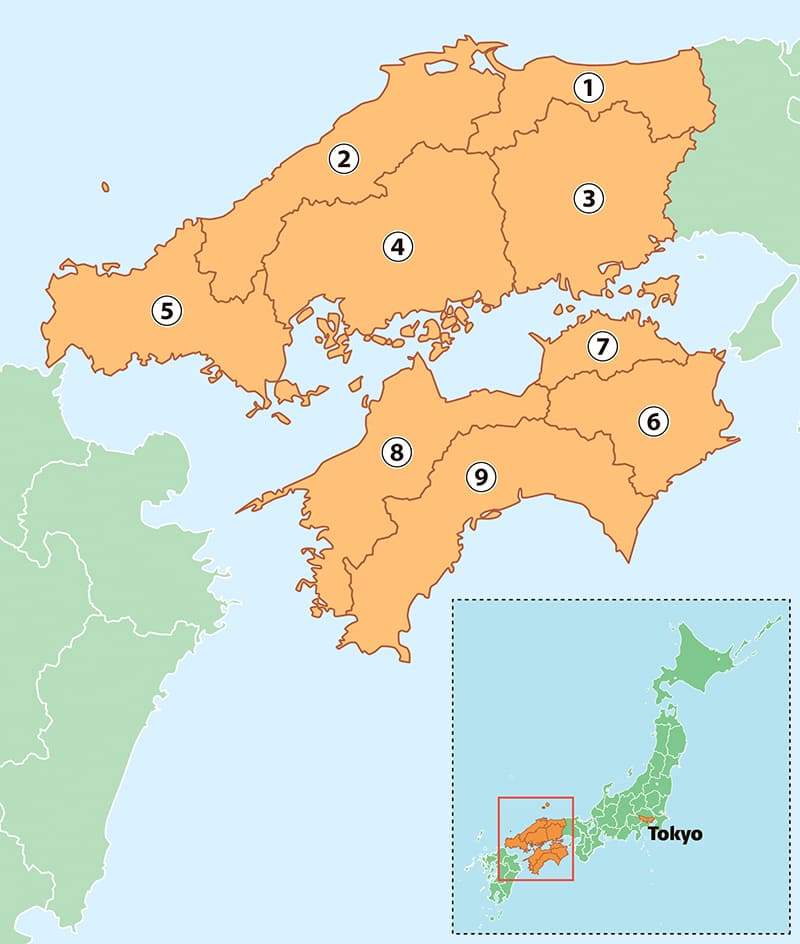
Travel info
Shinkansen from Tokyo Station to:
① Tottori Station: 5 hours (includes limited express trains)
② Matsue Station: 6 hours (includes limited express trains)
③ Okayama Station: 3 hours and 10 minutes
④ Hiroshima Station: 4 hours
⑤ Shin-Yamaguchi Station: 4 hours and 30 minutes
Flights from Haneda Airport to:
① Yonago Kitaro Airport: 1 hour and 25 minutes
② Izumo Enmusubi Airport: 1 hour and 20 minutes
③ Okayama Airport: 1 hour and 20 minutes
④ Hiroshima Airport: 1 hour and 30 minutes
⑤ Yamaguchi Ube Airport: 1 hour and 40 minutes
⑥ Tokushima Awaodori Airport: 1 hour and 20 minutes
⑦ Takamatsu Airport: 1 hour and 25 minutes
⑧ Matsuyama Airport: 1 hour and 35 minutes
⑨ Kochi Ryoma Airport: 1 hour and 30 minutes
(All times approximate and may vary by season.)
TOKYO x CHUGOKU
Tokyo
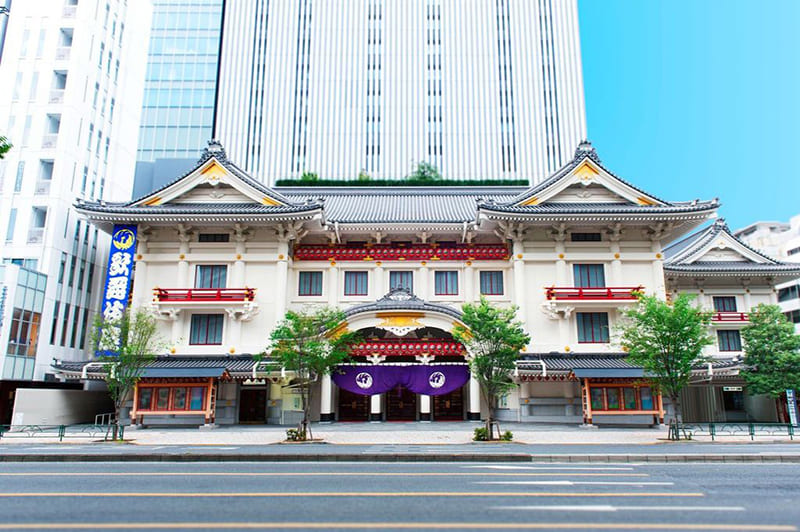
SHOCHIKU CO. LTD.
Beneath the skies of Japan’s capital, one can find virtually everything, from towers of glass and steel to shrines of ancient timber. The city boasts rainbows of electric lights, green oases of tranquility and glimpses of the past and the future. Tokyo is a city of beautiful paradoxes, and it invites visitors to discover them on their own terms.
A good place to start is the Kabukiza Theatre, which sets the stage for experiencing over four centuries of tradition that hasn’t been hidden away under a display case, but allowed to live, breathe and continue to capture the imagination. Kabuki reflects the contrasting spirit of Tokyo because it’s one part bombastic and over-the-top, telling stories of heroes battling demons or suffering lovers in the throes of passion, but also subtle, quietly beautiful and contemplative.
The theater, located in the heart of Ginza, is an embodiment of the turbulent spirit of this Japanese art, putting on plays written in the times of samurai in a building first constructed in 1889 and last rebuilt in 2013. Anyone who wishes to dip their toes in this world should take advantage of the Single Act Tickets. Even this system feels uniquely Tokyo-like, marrying convenience in a fast-paced world with a respectful admiration of living art. Captioning services in English are also available.
Once the curtain falls, there is Shinjuku Gyoen National Garden, one of Tokyo’s premier green space destinations. It’s where the city feels both intensely alive and calming as the noises of the biggest city in the world get lost in the branches of 10,000 trees. At nearly 60 hectares, there are many quiet paths that allow an escape from modernity into what used to be a feudal lord’s private estate and an imperial retreat. Today, the garden is also home to a tropical plant and orchid greenhouse rebuilt in 2012.
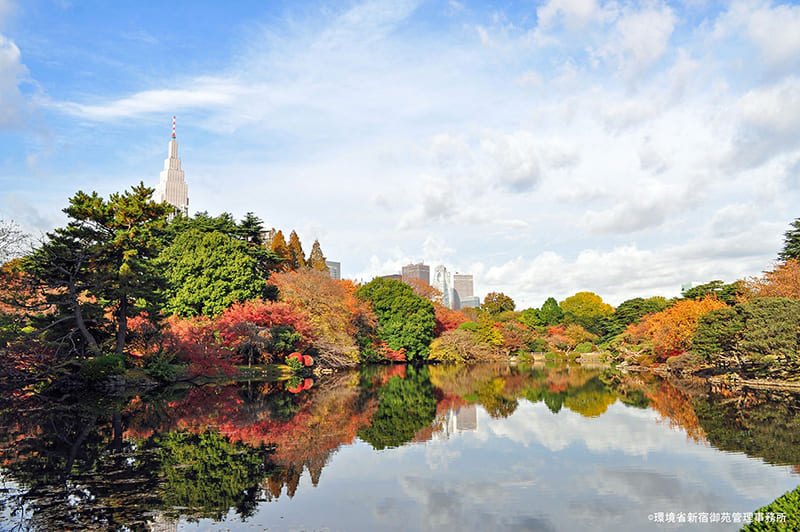
SHINJUKU GYOEN NATIONAL GARDEN OFFICE
Shinjuku Gyoen additionally reflects an important aspect of Tokyo — its multiculturalism. A mix of French, English and Japanese influences all work together in harmony, making this corner of Tokyo much more than the sum of its diverse parts, much like the eclectic capital itself.
Another highlight of the garden is how it changes throughout the year. Cherry blossoms in spring, red and gold maples in autumn, and the verdure of summer all keep families, individuals, and visitors from all around coming back for a respite from the hustle and bustle of the perpetually busy Shinjuku and Shibuya wards.
Tottori Prefecture ①
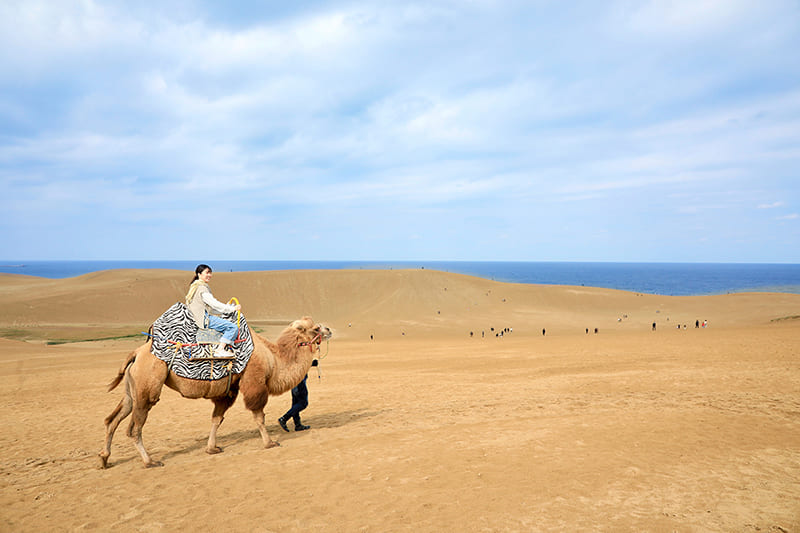
TOTTORI PREFECTURAL GOVERNMENT
Along the coast of the Sea of the Japan, in the western part of the country, Tottori Prefecture offers a welcoming escape into otherworldly landscapes and serene mountain vistas where travelers can reconnect with nature.
The Tottori Sand Dunes, a visual if not literal desert by the sea, expand our understanding of what Japanese nature really is, showing that it’s more than just green forests and rolling hills. Stretching for 16 kilometers, the dunes were crafted over thousands of years by sea winds accumulating sand into ever-shifting mounds and ridges that today are the largest landforms of their type in Japan. The same forces that created the dunes provide cool and refreshing breezes around October, the perfect month for exploring the area.
The view from atop the Uma no Se (Horse’s Back), the tallest dune ridge in Tottori Prefecture, gives visitors access to stunning panoramas of this natural wonder that sparkles like stars in the daytime against the backdrop of a glittering sea. The Tottori Sand Dunes can also be partially explored on camels, making for a one-of-a-kind photo souvenir of a trip to this part of Japan.
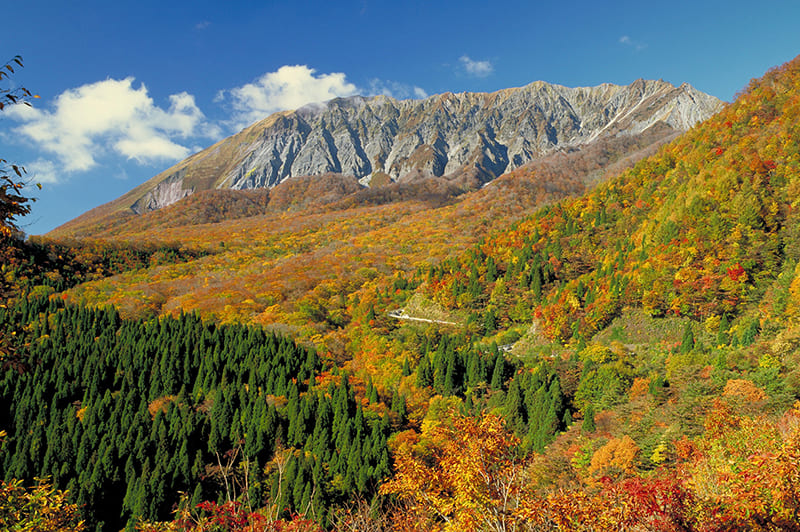
TOTTORI PREFECTURAL GOVERNMENT
More adventure-minded tourists can also enjoy “sandboarding” down the steep dunes or, for a truly unforgettable experience, soar high above the sea of sand on a tandem paragliding flight. Be sure to stick around till the early evening, when the setting sun turns the dunes gold and orange, creating a dreamlike world that is sure to become a memory of a lifetime.
For more of Tottori’s scenic showcase, there is Mount Daisen, the tallest mountain in the Chugoku region. Often voted one of the three most picturesque peaks in Japan, Tottori’s Daisen erupts with fiery red and glowing yellow foliage in the fall, which can be experienced from above using the Masumizu Highland’s Expanse Lift. An alternative way of getting up Mount Daisen is by hiking one of its many trails that cater to all levels of experience.
A literal and figurative highpoint of Mount Daisen is the Kagikake Pass. Located 900 meters above sea level, it offers unparalleled views of the mountain’s rugged southern side contrasting beautifully with colorful foliage in autumn. Travelers can also enjoy mist wrapping itself around the Daisen peaks like a veil on clear mornings, while in the evening, they can marvel at the entire mountainside igniting in the otherworldly glow of the sunset.
Shimane Prefecture ②
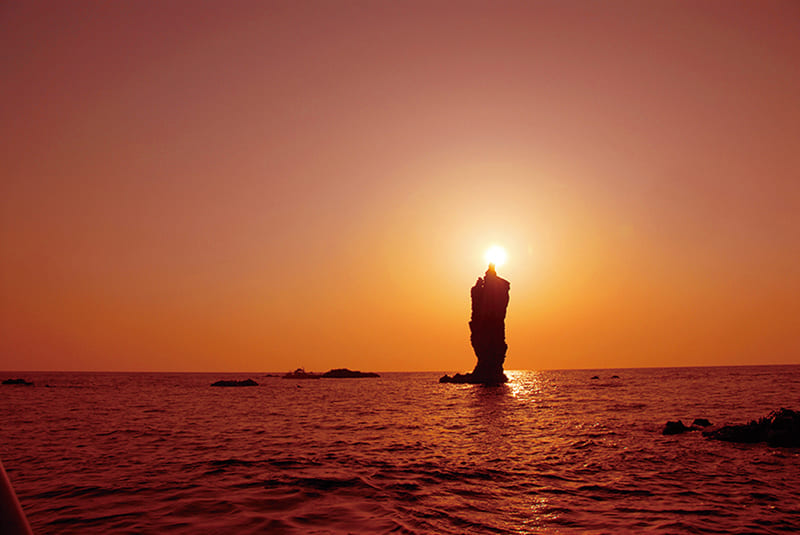
OKI ISLANDS GEOPARK MANAGEMENT BUREAU
Shimane overlooks the Sea of Japan and rewards travelers willing to journey to the western part of Honshu. Time flows differently here, perhaps owing to Shimane’s ancient heritage being deeply connected to the country’s mythology. Boasting a wealth of mystical landscapes, striking coastlines, art spaces and more, the two standouts of this prefecture are the Oki Islands and the Adachi Museum of Art.
The remote Oki Islands are about 40 to 80 kilometers off the coast of Shimane. The volcanic group’s four main inhabited landmasses are Dogo and the three Dozen Isles that were designated as a Global Geopark in 2013. Undeniably beautiful, there is a powerful majesty to the Oki Island scenery, from the jagged Kuniga coast to the 257-meter-high Matengai Cliff. At sunset, Candle Island glows with the sun behind it like its namesake, creating a unique photo opportunity for shutterbugs.
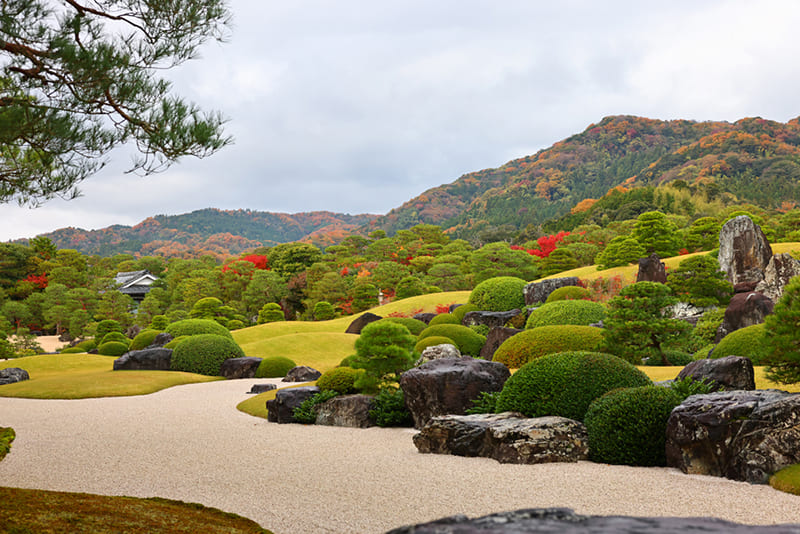
ADACHI MUSEUM OF ART
The islands are also a mecca for fans of outdoor activities. Kayaking along the craggy coastlines, snorkeling and diving in the Sea of Japan, and cycling or hiking across different islands are great ways to get to know this corner of Shimane. Nature lovers also shouldn’t miss the Dangyo Falls, selected as one of Japan’s top 100 waterfalls, found deep within the forest of Dogo. But it’s not the only mystical location around, as the Oki Islands are steeped in Shinto tradition. Home to over 100 shrines, the secrets of the islands can be discovered through the distinctive festivals and events that have been passed down through the ages.
For a change of pace after the Oki Islands, there is the Adachi Museum of Art in Yasugi on the mainland. The museum gardens have been ranked the best in Japan for over two decades by Sukiya Living Magazine: The Journal of Japanese Gardening, and have been rated three-stars by the Michelin Green Guide Japan. The sections of the sprawling 165,000-square-meter green space, featuring everything from a dry landscape garden to moss, pond and white gravel and pine gardens and an artificial waterfall, look like living pictures, reflecting the philosophy of the museum’s founder Zenko Adachi.
Inside, visitors can explore a curated collection of Japanese painting and ceramic works by modern Japanese masters and afterward enjoy sweets or matcha at the onsite Midori and Taikan cafes or the Juraku-an traditional tearoom.
Okayama Prefecture ③
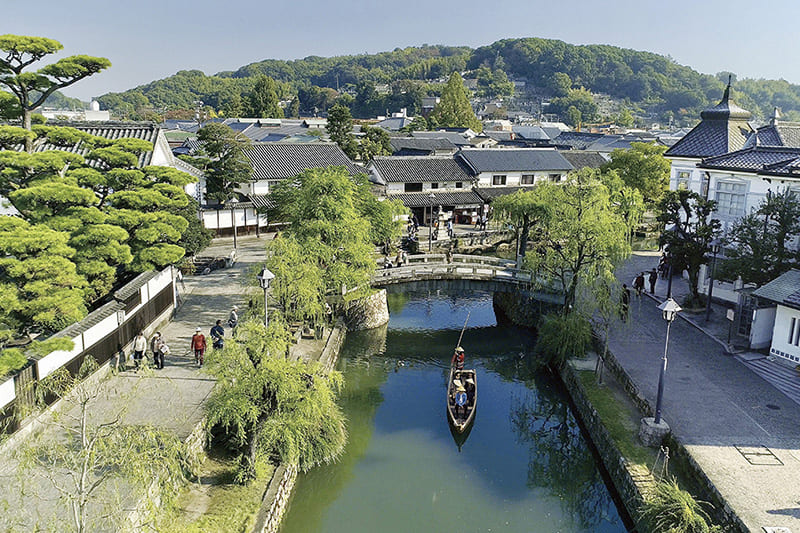
KURASHIKI VISITORS AND CONVENTION BUREAU
Visitors to Japan will find Okayama Prefecture nestled between Osaka and Hiroshima like a bridge of history and nature. It’s a place of immense beauty that lies in stillness, waiting patiently for travelers who wish to slow down and enjoy its centuries-old streets, rivers and gardens. The two destinations that define the spirit of Okayama are the Kurashiki Bikan Historical Area and the serene Okayama Korakuen Garden.
The Bikan Historical Area in the city of Kurashiki is a well-preserved townscape where time seems suspended between the area’s white-walled warehouses, clad in black tile, crisscrossing narrow lanes and the slow-moving Kurashiki River. Willow trees flank the riverbanks, their low branches brushing the mirror surface of the water, and visitors can explore the surrounding stone-paved alleys at their own pace. Here, the modern world just seems to fade away.
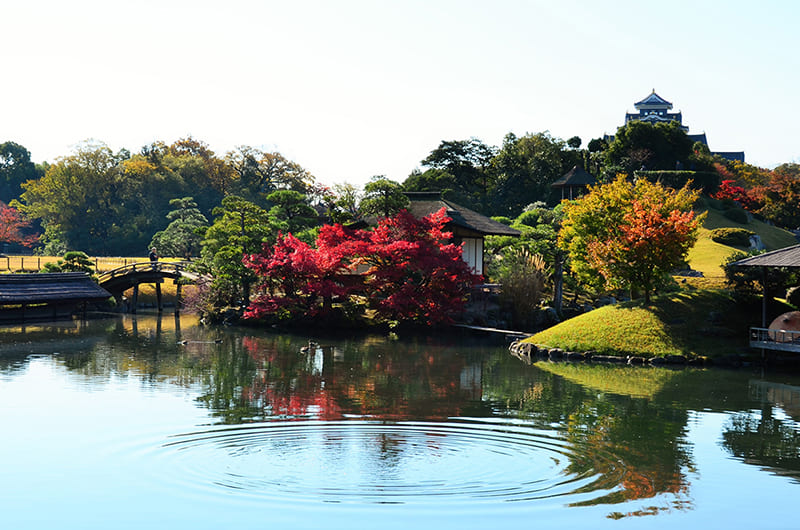
OKAYAMA KORAKUEN
The Bikan Historical Area can be explored from small wooden boats during the leisurely Kurashiki Kawabune-nagashi river tour that takes guests beneath stone bridges and past old merchant houses that have been part of the city for hundreds of years. At night throughout the year, lighting installments give the waterways an otherworldly glow that is not to be missed. Ultimately, though, Kurashiki’s historical district has been made for leisure walks and frequent stops to admire the traditional buildings that today serve as cafes and shops. At Morita Shuzo, the only sake brewery in the area, people can taste sake made using the same methods as during the Edo Period (1603 to 1868).
Edo culture also comes to life beyond Kurashiki’s Historical Area at Okayama Korakuen, one of Japan’s Three Great Gardens. Built in the 17th century for a powerful feudal lord, the garden is a strolling oasis designed for inner reflections rather than ostentatious display. Its spacious, open lawns, a rarity in the world of Japanese gardens, stretch out invitingly, while the garden’s artificial hill, historical buildings and other features are connected by quiet paths and gentle waterways. Sawa-no-ike, the large central pond, acts as a mirror enhancing the colors of the surrounding cherry blossoms in spring, maple leaves in autumn and clear blue skies all year round.
Weary visitors are invited to rest a while at Ryuten Rest House, where they can immerse themselves in traditional Japanese culture. In spring, summer and autumn (November), the garden organizes a Fantasy Garden evening display, where light and shadow transform the tranquil scenery into something like from a dream.
Hiroshima Prefecture ④
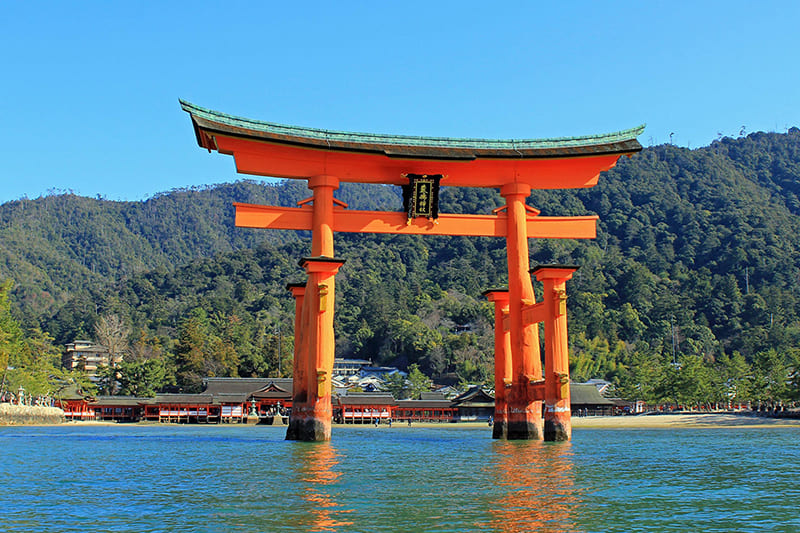
HIROSHIMA PREFECTURAL GOVERNMENT
Today most often remembered for its efforts toward achieving global peace, Hiroshima is also a place of beauty where human artistry meets the splendor of nature. Beyond the prefecture’s capital and its peace memorials, the story of Hiroshima is written in the vermillion of torii, the azure of the sea and the greenery of breathtaking panoramic vistas.
Visitors will find all those colors and more at Miyajima, home to the Itsukushima Shrine, a UNESCO World Heritage Site. It’s perhaps best known for its 16.8-meter torii that rises above the waters of the Seto Inland Sea at high tide, where it gently appears to float in a mesmerizing display of quiet majesty and tranquility. Working in tandem with the backdrop of Mount Misen, the Miyajima scenery enchants visitors, making them feel like they are entering the realm of the divine.
In autumn, the crimson and gold of the maple leaves give the island a cozy glow, which is magnified at sunset when the torii and shrine are bathed in an ethereal, warm twilight. In the old days of Shinto, all of Miyajima was worshipped as a deity, a literal “God Island,” and today the harmony between the environment and the early Heian-style shrine buildings puts one in a contemplative and introspective mood.
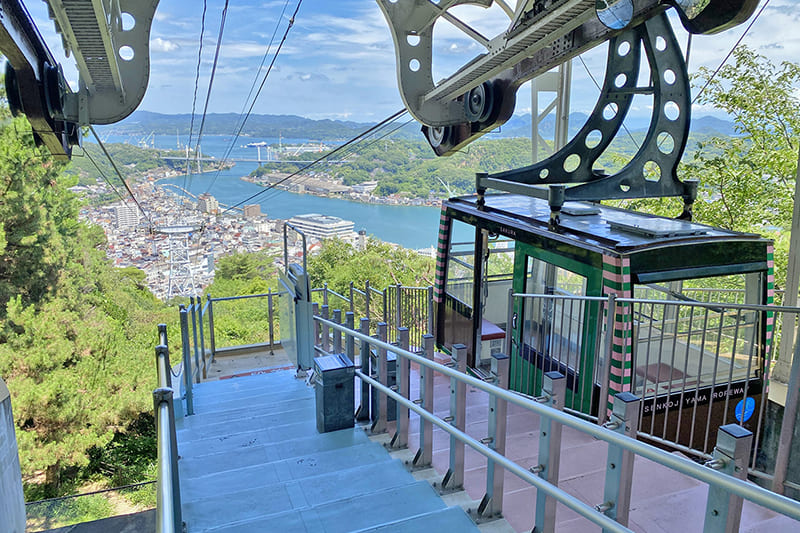
Before departing, people should visit the Omotesando Shopping Street leading to the shrine, where the scent of grilled conger eel mingles with the fragrance of *momiji-manju* (maple-leaf-shaped dumplings), that are filled with sweet adzuki bean paste and other flavors, which the island is famous for.
On the other side of Hiroshima Prefecture lies the port city of Onomichi, the best views of which are offered by the Mount Senkoji Ropeway. The three-minute journey from Nagaeguchi Station to the top of Mount Senkoji might be brief but it is full of unforgettable views of the tiled rooftops of Onomichi, the city’s Onomichi Channel and views all the way to the Shimanami Kaido cycling route linking the city with Shikoku and the islands in between.
Equally stunning views are available from the Peak observation deck at the summit. Unveiling Shikoku’s mountains in the distance on clear days, the sight of Onomichi’s lights sparkling in the darkness like low-hanging stars has been dubbed one of Japan’s Top 100 Night Views. Other can’t-miss spots in the area include the Path of Literature with its stone monuments dedicated to 25 literary figures connected with Onomichi, Senko Temple (founded in 806) and Tennei Temple with its iconic three-story pagoda.
Yamaguchi Prefecture ⑤
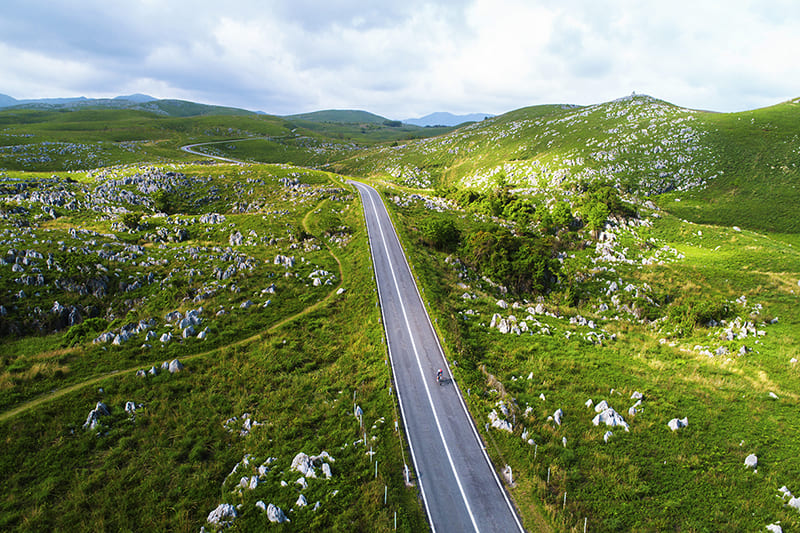
The westernmost prefecture on Honshu, Yamaguchi is an ancient land far removed from the neon glow of Japan’s cities. Once the site of massive tectonic forces and torrential rains, its current landscape of limestone plains and graceful rivers is a picture of calmness and natural wonders.
In Mine, the beating heart of Yamaguchi, visitors will find Akiyoshidai. The expansive limestone plateau stretches across the horizon, its rugged beauty the legacy of an ancient seabed being uplifted and shaped through countless centuries into Japan’s largest karst landscape. Designated as both a Ramsar Convention on Wetlands and a Special Natural Monument, Akiyoshidai’s limestone foundation bursts through the grassy expanse in places like the bones of the Earth. Akiyoshidai is today a popular spot for hiking among wildflowers while breathing in Yamaguchi’s cool, sweet-smelling air.
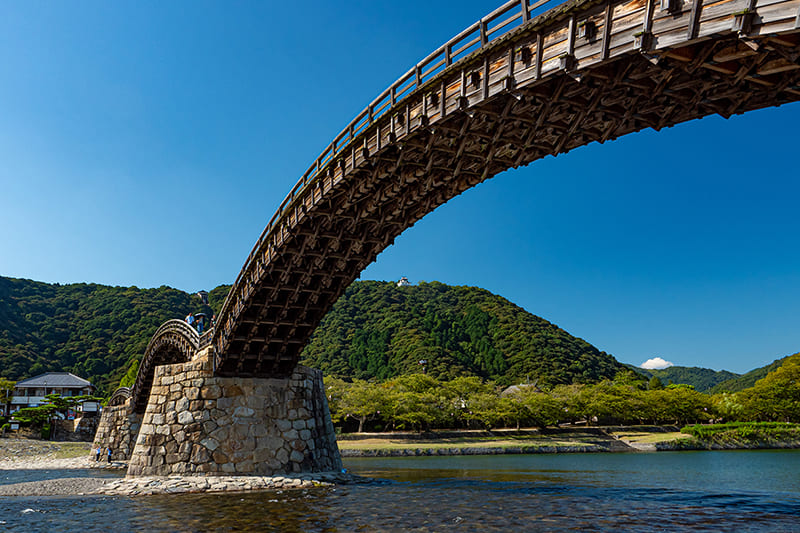
IWAKUNI TOURISM PROMOTION DIVISION
The plateau enchants both from above and below. The Akiyoshidai Karst Observatory unveils before travelers a stunning panorama of undulating green and white while 100 meters under the surface, the Akiyoshido cave awaits amateur spelunkers. About 1 kilometer of Akiyoshido (one of the largest limestone caves in Japan) is open to visitors, ushering them into a hushed, ancient cathedral of underground marvels like the spellbinding Golden Pillar, carved by water over millennia. The cave maintains a steady temperature of 17 degrees Celsius throughout the year, creating its own little world that echoes with eternity.
However, there are still many manmade attractions in Yamaguchi Prefecture, including the Kintaikyo Bridge that crosses the Nishiki River in Iwakuni. The five-arch wooden structure, first constructed in 1673 and rebuilt several times, was a masterpiece of traditional Japanese engineering. The bridge was unfortunately destroyed in a 1950 typhoon, but was rebuilt three years later as close to the original design as possible, without losing its charm. Today, it continues to stand as a symbol of humanity’s will to overcome seemingly impossible challenges with style and elegance.
Bringing to mind the backs of fish swimming upstream, the Kintaikyo Bridge also represents harmony between the natural world and human skill. In autumn, crimson leaves frame the bridge in fiery colors, attracting visitors from all over who wish to walk Kintaikyo’s planks. Whether one seeks the poetry of landscapes or the power of human spirit, Yamaguchi Prefecture is the place.
TOKYO x SHIKOKU
Tokushima Prefecture ⑥
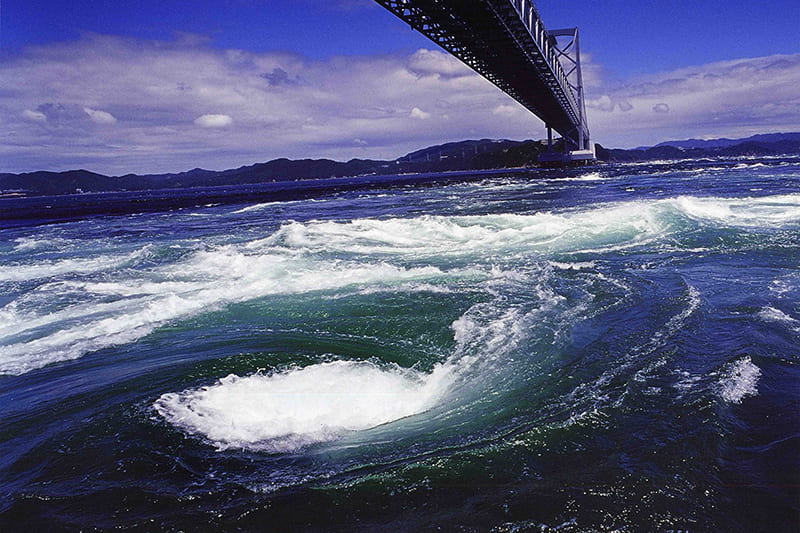
NARUTO UZUSHIO TOURIST ASSOCIATION
Shikoku’s eastern-most prefecture, Tokushima is where primeval nature meets ancient traditions. The land may seem intimidating at first, but there’s an inner light to it that warms anyone who encounters it.
Take the Naruto Whirlpools, for example. Found off the coast between Shikoku and Awaji Island, where the Seto Inland Sea collides with the Pacific, the Naruto Strait boils with one of the world’s fastest and strongest tidal currents, producing a ferocious ocean roar. But a closer look reveals the beauty hidden within the massive vortexes, making them seem more like a frenzied dance of nature.
One of the best places to discover another side of the Naruto Whirlpools is from the decks of sightseeing boats, which pass close enough to the pools to allow visitors to feel the spray of the sea on their faces.
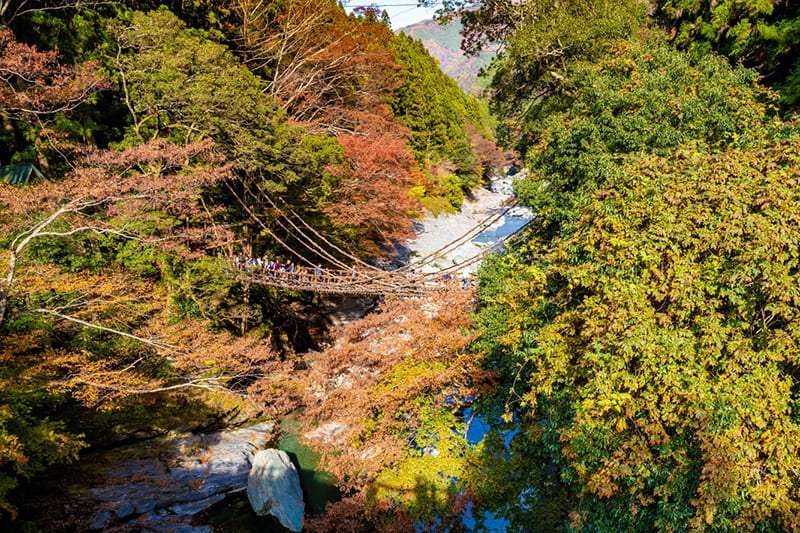
MIYOSHI TOURISM ASSOCIATION
Those preferring to admire the sea from land should stroll the Uzu no Michi (whirlpool road). This 450-meter-long walkway with glass windows in the floor extends beneath the Onaruto Bridge connecting Shikoku and Awaji, giving visitors a bird’s-eye view of the maelstrom below. For commemorative photos, people can visit the Senjojiki Observation Deck with the Naruto Strait in the background, or the Ochaen Observatory, a location associated with the former lords of Tokushima, which provides sweeping panoramas of the Onaruto Bridge.
On the other side of the prefecture, another marvel attracts travelers looking for a little adventure. Deep in the mysterious Iya Valley stretches the Iya Kazurabashi (Vine Bridge of Iya), a National Important Tangible Folk Cultural Property and one of Japan’s three most interesting bridges. Some 14 meters above the emerald waters of the Iya River, this 45-meter-long, 2-meter-wide suspension bridge is woven entirely from hardy local vines, weighing close to six tons. Every step on the swaying structure, built sometime between the ninth and 12th centuries, is a thrill combined with a test of confidence in the craftsmanship of ancient Japanese engineers.
In autumn, crimson leaves set the Iya Valley ablaze with color, and by nightfall, the illuminated bridge creates a magical sight, though crossing it after dark is forbidden. Nearby, travelers will find the Biwa Waterfall cascading 50 meters down Tokushima’s cliffs, as well as riverside paths inviting introspection in the heart of nature.
Kagawa Prefecture ⑦
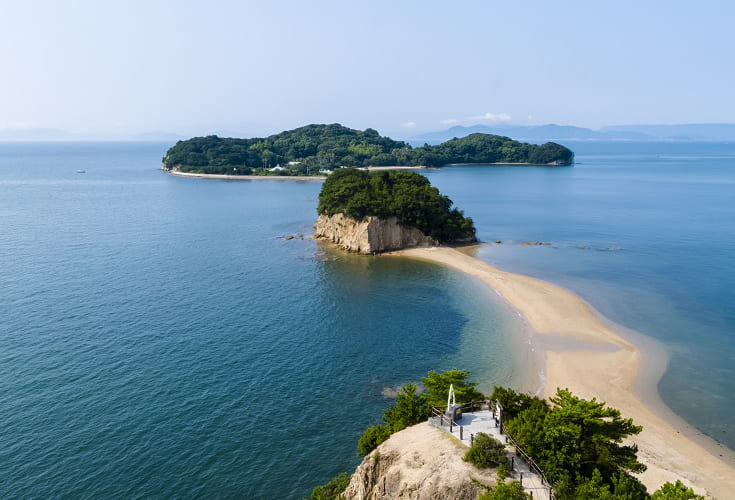
CUBIC-TT
The smallest of Japan’s 47 prefectures, Kagawa rests quietly on the shores of the Seto Inland Sea on the northeastern tip of Shikoku, where the sun falls softly on sprawling olive groves and ancient shrines.
Shodoshima sits north off Kagawa’s mainland. It is probably best known for its olives that visitors can enjoy at the Shodoshima Olive Park with its replica Greek windmill and green olive groves. Fans of the Studio Ghibli movie “Kiki’s Delivery Service” also shouldn’t miss the general store that served as an inspiration for the film’s location and can today be found at the Olive Park.
The best time to experience the treasures of Shodoshima is around October, the time of the Olive Harvest Festival when residents celebrate the island’s unique crop and give thanks for bountiful harvests to the beat of traditional Japanese drums at the Autumn Festival Taikodai Dedication. Fall is also when the nearby Kanka-kei, which is considered one of the three most scenic gorges in Japan, is painted red and gold with autumn foliage that is especially beautiful when viewed from the ropeway that runs high above it.
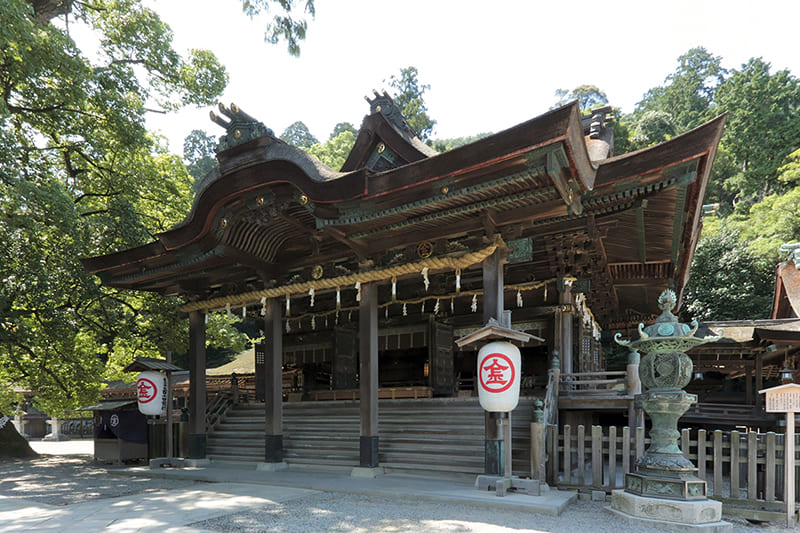
Angel Road, on the other hand, can be enjoyed all year round. It’s an ephemeral path between Shodoshima and a string of islets that only appears at low tide. It is said that lovers who cross the sandbar together while holding hands will be together forever, almost as if the sea itself blessed their union.
Kagawa has great respect for the sea. On the mainland, the Kotohira Shrine (also known as Konpira-san) acts as a patron of seafarers. It’s 785 steps to the main shrine but the truly devoted go for the full 1,368 steps leading to the shrine’s inner sanctum. The approach is lined with rest areas as well as places selling souvenirs, noodles and local traditional confectionery, making the climb very enjoyable. The reward at the end is an unforgettable view of the Sanuki Plain and the Seto Inland Sea.
At the base of the approach sits the Former Konpira Grand Theater, popularly known as Kanamaru-za, Japan’s oldest surviving kabuki playhouse. Built in 1835, it echoes with Edo Period culture that is being kept alive with the annual Shikoku Konpira Kabuki Performance, held every spring. To step inside the theater is to step back in time to a world of plastered walls, wooden pillars and floors and flickering lanterns.
Ehime Prefecture ⑧
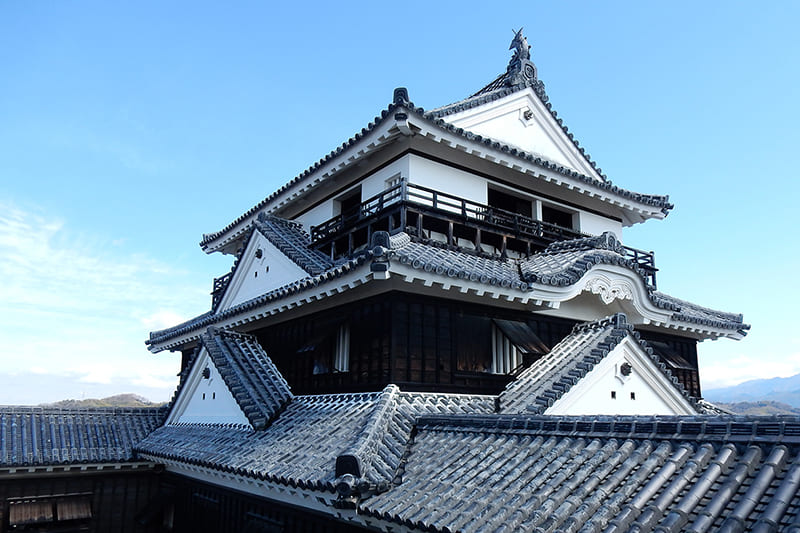
MATSUYAMA CASTLE GENERAL OFFICE
Perched on the western side of Shikoku, Ehime Prefecture is where hot spring mist rises to the skies and encounters the land’s fortified history in a cozy corner of Japan overlooking the Seto Inland Sea.
Atop Mount Katsuyama, 132 meters above sea level, Ehime’s Matsuyama Castle is a fortress that inspires awe, stokes the imagination and keeps history alive. Built in the early 17th century, the castle is regarded as one of the last surviving complete fortifications from the Edo Period, boasting a National Important Cultural Property designation. The site is home to 21 important cultural property buildings, as well as a unique stone wall known as a “climbing stone wall” that utilizes a slope, conveying the history of Japanese castle architecture.
The view from the castle’s main keep was awarded a star in the Michelin Green Guide Japan and is like a living painting, with the city of Matsuyama below and the shimmering Seto Inland Sea visible in the distance on clear days. At night, the towering silhouette of an illuminated Matsuyama Castle is so grand and brimming with the intense power of history that it is no wonder it has been recognized as one of Japan’s Night View Heritage Sites.
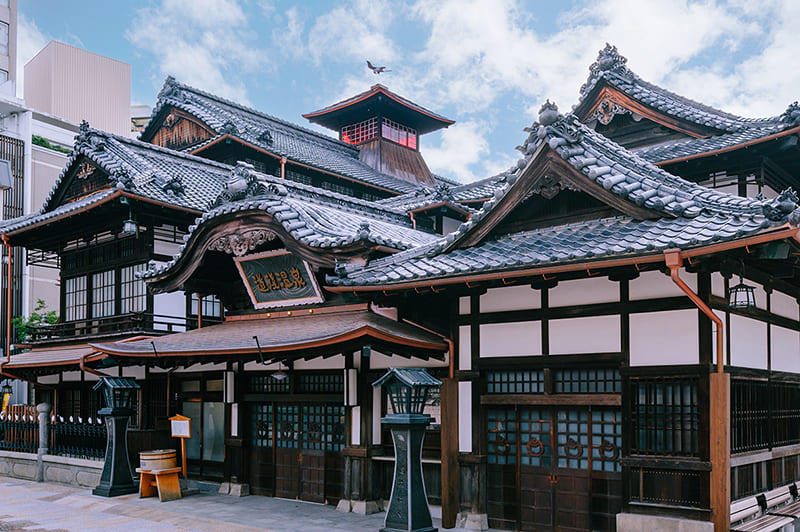
MATSUYAMA MUNICIPAL GOVERNMENT
The castle grounds, like the Ninomaru Historical Garden, offer a relaxing alternative to the imposing tower keep, especially in October and November when they glow with the colors of autumn. The castle is easily accessible via ropeway or chairlift.
A short tram ride away awaits the steamy embrace of Dogo Onsen. Known as Japan’s oldest hot spring resort with over 3,000 years of history, Dogo Onsen has soothed the tired bones and muscles of sovereigns, samurai, artists and countless others. The Dogo Onsen Honkan, or main building, is a multistory wooden structure that became the first bathhouse designated a National Important Cultural Property in 1994. Inside, labyrinthine hallways and staircases lead visitors to six bathing courses where mineral-rich waters flow freely directly from an ancient spring renowned for its rumored beautifying effects on the skin.
Around the Honkan, narrow streets are filled with shrines, museums and shops selling local sweets and souvenirs. Be it Dogo Onsen’s Honkan, Tsubaki-no-Yu and Asuka-no-Yu annexes or free footbaths and hand baths in the area, every soak in the hot springs of Ehime feels like being awash in history.
Kochi Prefecture ⑨
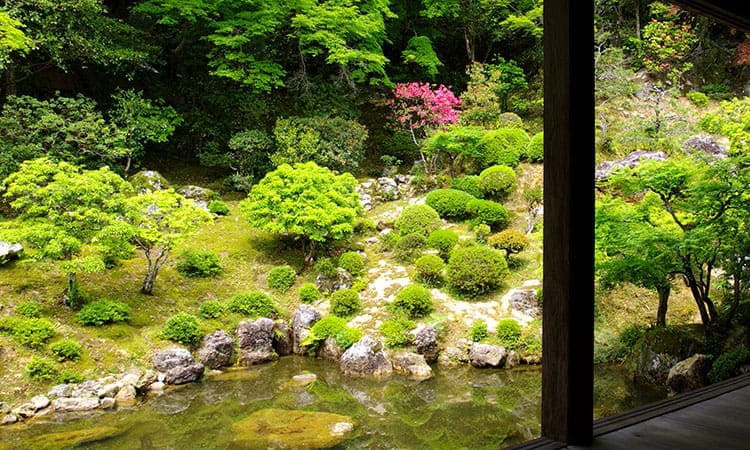
MOUNT GODAI CHIKURIN TEMPLE
Stretching along the southern coast of Shikoku, Kochi Prefecture may constantly be facing the raw, untamed power of the Pacific, but it nurtures an atmosphere of serenity, oneness with nature and appreciation of life. Two places truly exemplify this.
Chikurinji temple in the city of Kochi has watched over these lands for over 1,300 years from the slopes of Mount Godai. It’s one of the 88 stops on the Shikoku Henro, a 1,400-kilometer circular pilgrimage route on Shikoku, which exudes tranquility and creates a space for deep reflection. Chikurinji is famous for its garden, designated as one of Kochi’s three most beautiful green spaces and a National Place of Scenic Beauty. In autumn, the stone paths and mossy grounds ignite in a blaze of crimson and amber, making the temple a popular foliage-viewing spot.
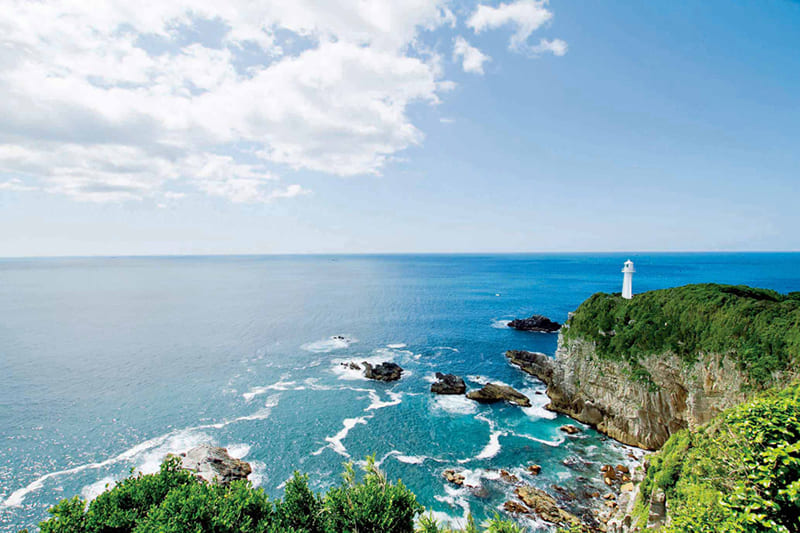
TOSASHIMIZU TOURISM ASSOCIATION
At the heart of the temple stands the main hall, a National Important Cultural Property, and nearby is Kochi Prefecture’s only five-story pagoda, standing 31.2 meters tall. This cypress tower, rebuilt in 1980, feels as timeless as the lush forest that surrounds it. In appreciation of its natural setting, the temple invites visitors to wander around through shaded paths and past centuries-old monuments where history and nature share the same space in perfect harmony.
Over 150 kilometers away, visitors can find Cape Ashizuri at the southernmost tip of Shikoku. Ashizuri and Chikurinji may seem very different travel destinations at first glance, but both foster a contemplation of the infinite. Cape Ashizuri juts defiantly into the Pacific, where steep cliffs meet the boundless sky above what looks like a never-ending expanse of water, curving ever so gently in the distance. Walking trails weave along the cliffs, offering breathtaking views at every turn. Below the surface, the waters swell with marine life, making the area a mecca for scuba-diving and snorkeling. Due to all of this and more, Cape Ashizuri has earned two stars in the Michelin Green Guide Japan.
Another unforgettable part of the cape is the chalk-white Cape Ashizuri Lighthouse, one of the largest in Japan, rising majestically against the sapphire sea and sky, a steadfast sentinel for sailors and other seafarers. It reminds all that while Ashizuri is beautiful, it is an untamed and wild kind of beauty — elemental, vast and awe-inspiring, as befitting a prefecture that’s constantly facing the world’s largest ocean.









